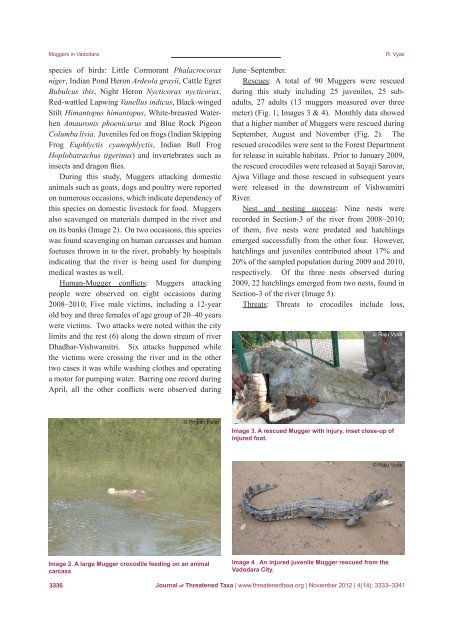View - Journal of Threatened Taxa
View - Journal of Threatened Taxa
View - Journal of Threatened Taxa
Create successful ePaper yourself
Turn your PDF publications into a flip-book with our unique Google optimized e-Paper software.
Muggers in Vadodaraspecies <strong>of</strong> birds: Little Cormorant Phalacrocoraxniger, Indian Pond Heron Ardeola grayii, Cattle EgretBubulcus ibis, Night Heron Nycticorax nycticorax,Red-wattled Lapwing Vanellus indicus, Black-wingedStilt Himantopus himantopus, White-breasted WaterhenAmauronis phoenicurus and Blue Rock PigeonColumba livia. Juveniles fed on frogs (Indian SkippingFrog Euphlyctis cyanophlyctis, Indian Bull FrogHoplobatrachus tigerinus) and invertebrates such asinsects and dragon flies.During this study, Muggers attacking domesticanimals such as goats, dogs and poultry were reportedon numerous occasions, which indicate dependency <strong>of</strong>this species on domestic livestock for food. Muggersalso scavenged on materials dumped in the river andon its banks (Image 2). On two occasions, this specieswas found scavenging on human carcasses and humanfoetuses thrown in to the river, probably by hospitalsindicating that the river is being used for dumpingmedical wastes as well.Human-Mugger conflicts: Muggers attackingpeople were observed on eight occasions during2008–2010; Five male victims, including a 12-yearold boy and three females <strong>of</strong> age group <strong>of</strong> 20–40 yearswere victims. Two attacks were noted within the citylimits and the rest (6) along the down stream <strong>of</strong> riverDhadhar-Vishwamitri. Six attacks happened whilethe victims were crossing the river and in the othertwo cases it was while washing clothes and operatinga motor for pumping water. Barring one record duringApril, all the other conflicts were observed duringR. VyasJune–September.Rescues: A total <strong>of</strong> 90 Muggers were rescuedduring this study including 25 juveniles, 25 subadults,27 adults (13 muggers measured over threemeter) (Fig. 1; Images 3 & 4). Monthly data showedthat a higher number <strong>of</strong> Muggers were rescued duringSeptember, August and November (Fig. 2). Therescued crocodiles were sent to the Forest Departmentfor release in suitable habitats. Prior to January 2009,the rescued crocodiles were released at Sayaji Sarovar,Ajwa Village and those rescued in subsequent yearswere released in the downstream <strong>of</strong> VishwamitriRiver.Nest and nesting success: Nine nests wererecorded in Section-3 <strong>of</strong> the river from 2008–2010;<strong>of</strong> them, five nests were predated and hatchlingsemerged successfully from the other four. However,hatchlings and juveniles contributed about 17% and20% <strong>of</strong> the sampled population during 2009 and 2010,respectively. Of the three nests observed during2009, 22 hatchlings emerged from two nests, found inSection-3 <strong>of</strong> the river (Image 5).Threats: Threats to crocodiles include loss,© Raju Vyas© Pritesh PatelImage 3. A rescued Mugger with injury, inset close-up <strong>of</strong>injured foot.© Raju VyasImage 2. A large Mugger crocodile feeding on an animalcarcassImage 4 . An injured juvenile Mugger rescued from theVadodara City.3336<strong>Journal</strong> <strong>of</strong> <strong>Threatened</strong> <strong>Taxa</strong> | www.threatenedtaxa.org | November 2012 | 4(14): 3333–3341

















